Bouvier Des Flandres (original) (raw)
The Bouvier Des Flandres is also known as the vuilbaard (dirty beard), koehond (cow dog), and toucher de boeuf or pic (cattle driver).
The Bouvier des Flandres (pronounced “boo-vee-ay duh Flan-derz”) is a Flemish herding dog characterized by a powerful, compact body, a very large head, drooping ears, and a short tail. The long and shaggy double coat, which consists of a very rough outer coat and a softer undercoat, can be fawn, brindle, black, gray, or blonde. This is complemented by a particularly prominent beard and mustache.
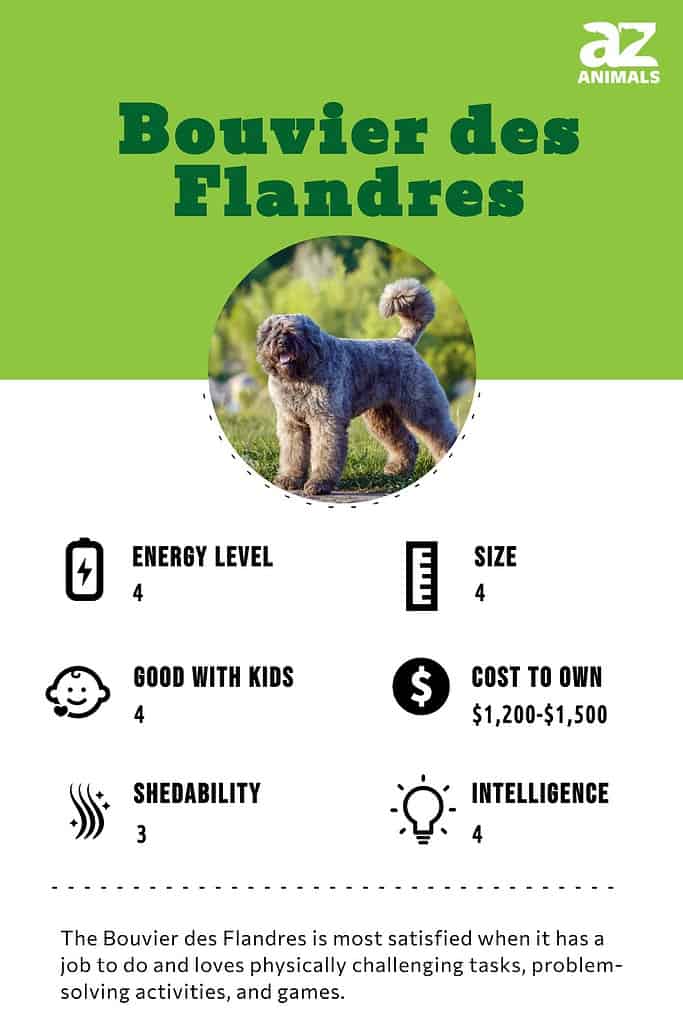
3 Pros and Cons of Owning a Bouvier des Flandres
| Pros! | Cons! |
|---|---|
| Friendly and LoyalThe Bouvier is a gentle, people-oriented dog. | High Physical NeedsThe Bouvier can be a whirlwind of activity. |
| Hard-working and RelentlessThis breed has a strong working drive. | Strong Herding InstinctsThis breed will herd anything and everything if you let it. |
| VersatileThe Bouvier des Flandres is able to learn lots of different tasks. | May Require ClippingThe long coat may need to be trimmed on occasion. |
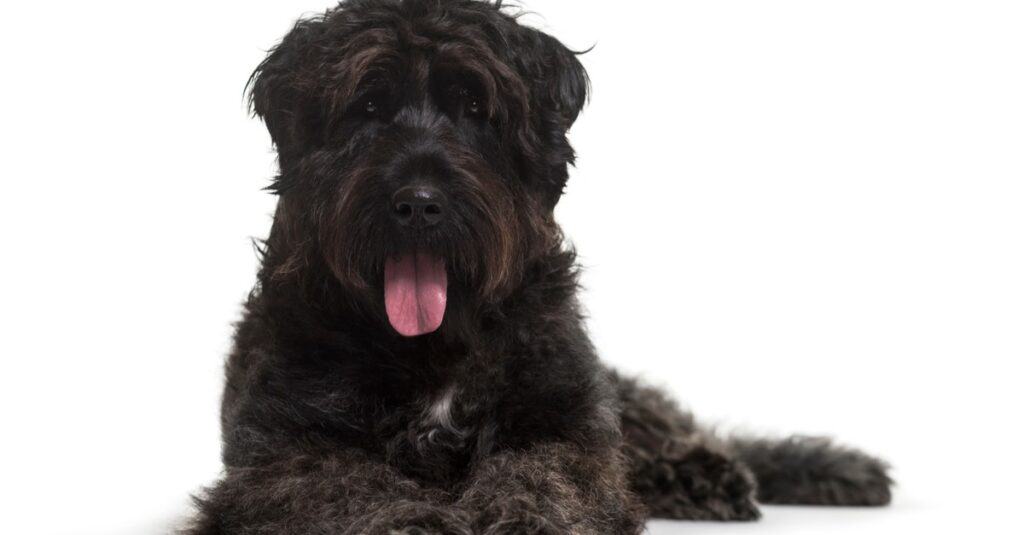
The Bouvier des Flandres is a gentle, friendly, and loyal breed.
©Eric Isselee/Shutterstock.com
Evolutions and Origins
This breed may have arisen in medieval times from crosses between European hounds and local farm dogs. Today Flanders refers to the Dutch-speaking part of northern Belgium, but at the time of the dog’s development in the Middle Ages, the region straddled the border between France and the Holy Roman Empire. Because of this tangled history, both France and Belgium can claim it as a native breed.
This versatile dog has historically played many different roles. It was originally developed to help farmers herd sheep, drive cattle, pull carts, and as a watchdog to guard the property, but it was later adopted for police work, search, and rescue operations, guiding the disabled, and an overall household companion.
During World War I, when the fields of Flanders became a scarred and bloody battlefield, this breed earned a distinguished record as a trench dog, carrying messages and pulling ambulance carts. Unfortunately, the combat took its toll and nearly drove the breed to extinction. Its fortunes improved greatly after World War II thanks to the efforts of dedicated breeders. It is a popular breed in dog sports, particularly in agility, obedience, and herding trials.
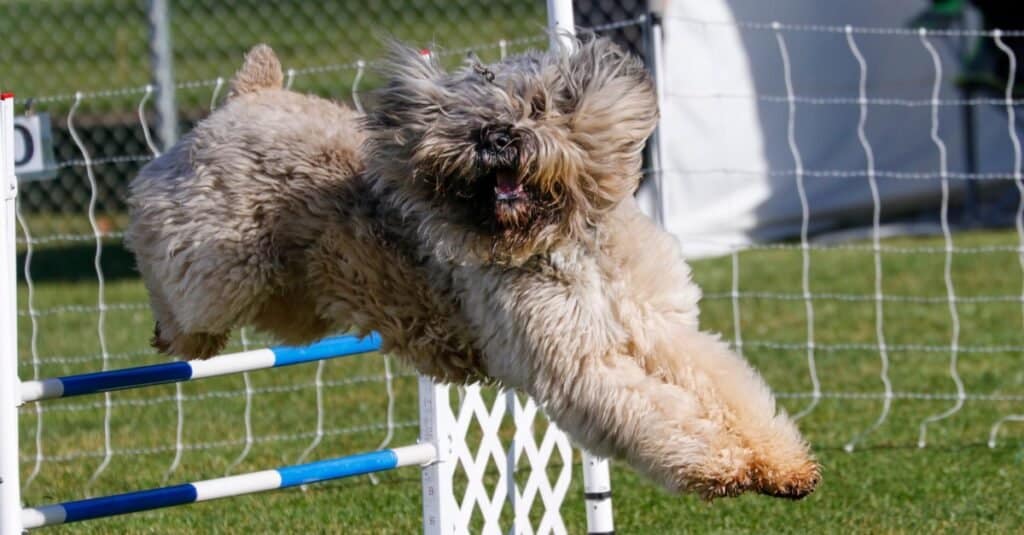
Bouvier des Flandres dogs perform well in agility trials.
©GoDog Photo/Shutterstock.com
Size and Weight
The Bouvier des Flandres is a large dog; while it isn’t very long, it’s certainly tall and muscular. The accepted standard does not, unfortunately, allow for miniature Bouviers, but it may be possible to produce a miniature version with a mix. The Beagle and the miniature Poodle are both good candidates for crosses.
| Height (Male) | 24.5 to 27.5 inches |
|---|---|
| Height (Female) | 23.5 to 26.5 inches |
| Weight (Male) | 70 to 110 pounds |
| Weight (Female) | 70 to 110 pounds |
Common Health Issues
The Bouvier has a decent lifespan of around 10 to 12 years, but it is particularly susceptible to a list of different health conditions, including deafness, glaucoma, myopathy (muscle weakness), cataracts, hypothyroidism, and cancer. There is also a chance it may inherit some rarer disorders. Laryngeal paralysis is an upper respiratory problem caused by the degeneration of muscles and nerves. Subaortic stenosis is an obstruction in the blood flow caused by the narrowing of a heart valve. Hip and elbow dysplasia results in the joints slipping loose from the socket.
Bloating, which affects many deep-chested dog breeds, is caused by a buildup of gas in the stomach; this potentially life-threatening condition twists and expands the stomach to dangerous degrees. Symptoms include abdominal swelling, excess salivating, and vomiting or retching; if this should occur, then seek medical attention immediately. It is possible to improve your dog’s chances at a happy, healthy life by making sure the breeder has done the necessary tests to ensure that their stock is free of known inheritable issues.
Regular checkups at the vet are also necessary to catch health problems early. In summation, these are the most common health problems with the Bouvier:
- Deafness
- Glaucoma and cataracts
- Hypothyroidism
- Cancer
- Myopathy.
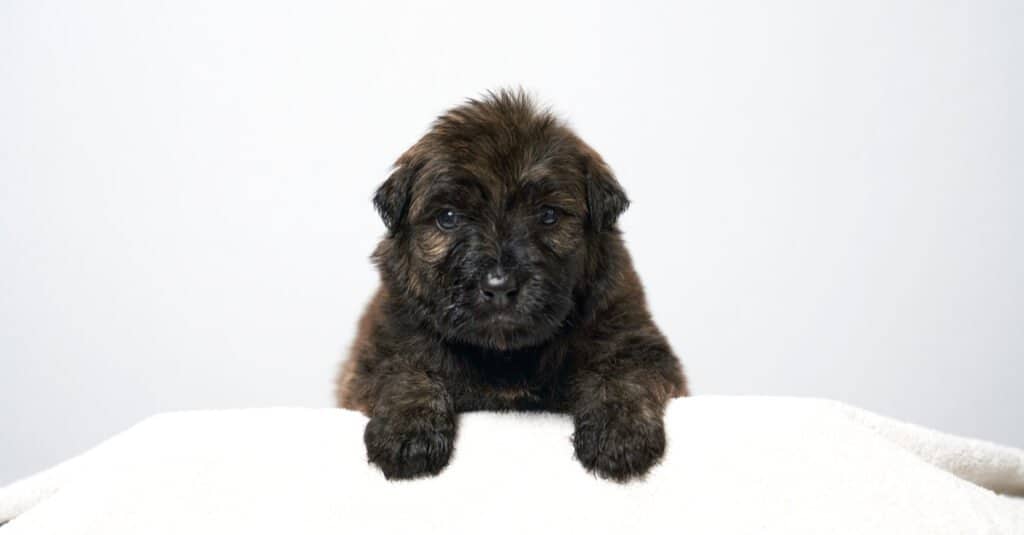
The Bouvier is susceptible to common health issues as well as some rarer ones.
©Bridgemont Photography/Shutterstock.com
Temperament
The Bouvier has an all-around good temperament; it is fairly affectionate, playful, gentle, loyal, and devoted to the family. But despite its friendly personality, this breed is most satisfied when it has a job to do. It loves games, problem-solving activities, and physically challenging tasks. You will need to be particularly creative in the kinds of activities you do with your dog. If left alone for too long without any sense of direction, there is a chance it could turn into destructive behavior.
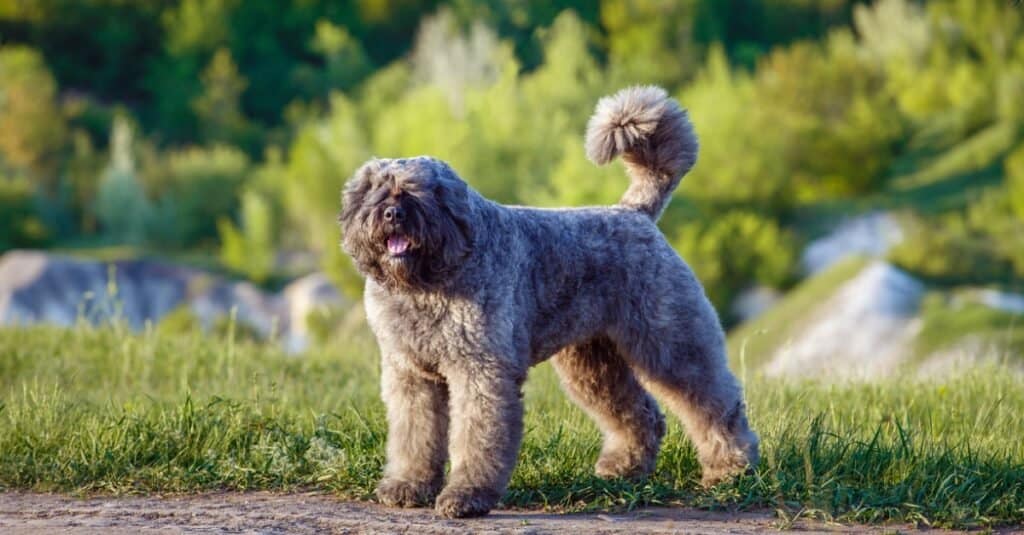
This breed loves games and physically challenging tasks.
©iStock.com/~User7565abab_575
How to Take Care of the Bouvier des Flandres
Despite its pleasant, even-tempered personality, the Bouvier probably isn’t a good choice for casual dog owners. This breed requires someone who can keep up with its frenetic whirlwind of activity and exercise. While it can adapt to smaller homes and apartments, this breed will need plenty of outdoor space to run and play.
The Best Dog Food for the Bouvier des Flandres
The Bouvier will need a few cups of high-quality dog food every day, preferably lower in protein than the typical dog food. The exact amount of food will depend on the dog’s age, activity level, and size. Since this breed is unfortunately prone to bloating, you should divide up the meals into a few per day. Both commercially made and homemade meals are acceptable.
Due to the breed’s propensity for the heart condition subaortic stenosis, look into the link between legumes and heart failure in dogs, and select a legume-free dog food.
At A-Z Animals, we choose Canidae Pure Limited Ingredient Premium Adult Dry Dog Food as the best dog food for the Bouvier des Flandres.
Made with no wheat, corn, soy, or problematic legumes like peas and lentils, this clean recipe delivers taurine from real beef, a nutrient that aids in heart and eye health. Plus, the probiotics mitigate digestive troubles and antioxidants contribute to a worry-free immune system.
Click below to find Canidae Pure Limited Ingredient Premium dog food on Amazon.
[lasso id=”428015″ link_id=”1770258″ ref=”amzn-canidae-pure-limited-ingredient-adult-dry-dog-food-wholesome-grains”]
Maintenance and Grooming
Despite the very thick coat of fur, the Bouvier needs to be brushed probably no more than once or twice a week with a simple brush and comb; special attention should be paid to the beard. This breed does shed a moderate amount (it is not hypoallergenic), but most of the hair will be caught up within the double coat, causing it to mat. The Bouvier should be ideally trimmed once every month or two, especially if you intend to exhibit it on the dog show circuit.
Owners may also need to trim the nails on occasion to prevent them from cracking or clicking on the floor. Brush the teeth on a regular basis to prevent gum and tooth disease. Finally, check the ears for signs of infection and then clean them out.
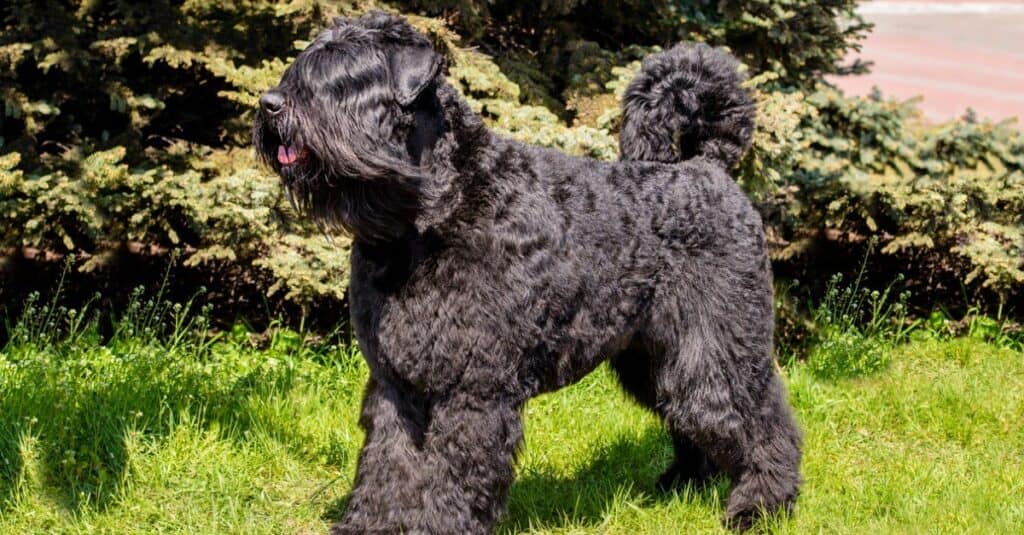
Even though Bouvier des Flandres dogs have thick coats they only need to be brushed 1-2 times per week.
©iStock.com/volofin
Training
The Bouvier is extremely eager to please its owner and follow commands. Its strong-willed and relentless nature is easily channeled into positive directions. Some gentle guidance and patience are all that’s required to get the most out of it.
Exercise
The Bouvier probably needs at least an hour of exercise per day in the form of long walks, vigorous hiking, jogging, and even accompanying a biking owner. This breed also excels at agility trials, tracking, herding events, obedience challenges, and general showmanship. It might be a good idea to have a large and enclosed yard where the dog can run around freely for a time. Since it does have a strong herding drive, you should be careful about letting it off the leash.
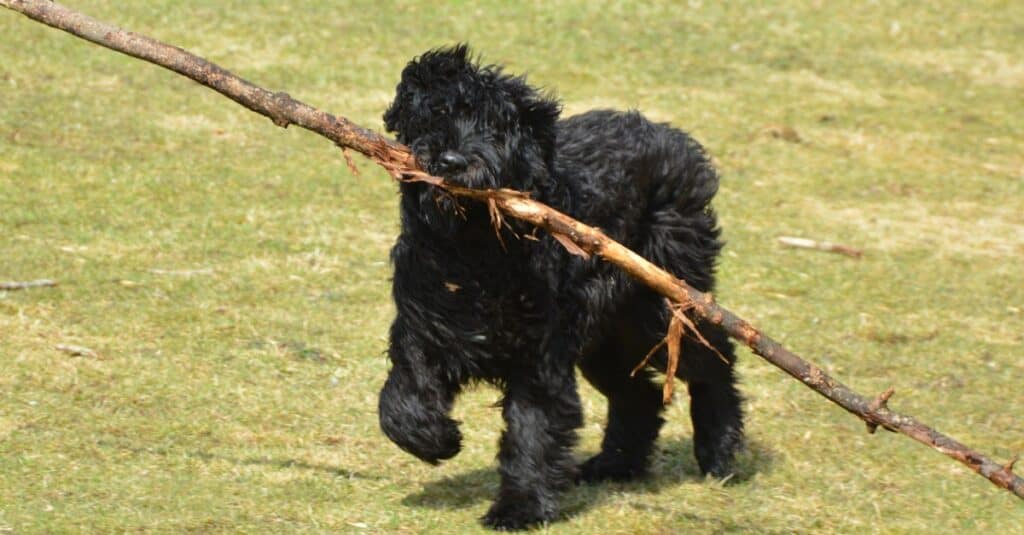
Bouvier des Flandres dogs need at least an hour of exercise daily.
©iStock.com/Carol Hamilton
Puppies
Bouvier puppies need to be trained and socialized from the earliest possible age. Doggie daycare/kindergarten, dog parks, play dates, and training classes can all help to shape puppies into well-behaving adults. Some of their herding instincts are endemic and built-in, but they can be controlled with enough careful training and guidance. If you’re not careful, you might find the dog herding people as well as animals.
Crate training, while not strictly necessary, can help with housebreaking and behavioral issues, both as a puppy and throughout the dog’s entire life. Another important thing to keep in mind is that exercise should be limited in duration and intensity until the puppy matures at around two years of age.
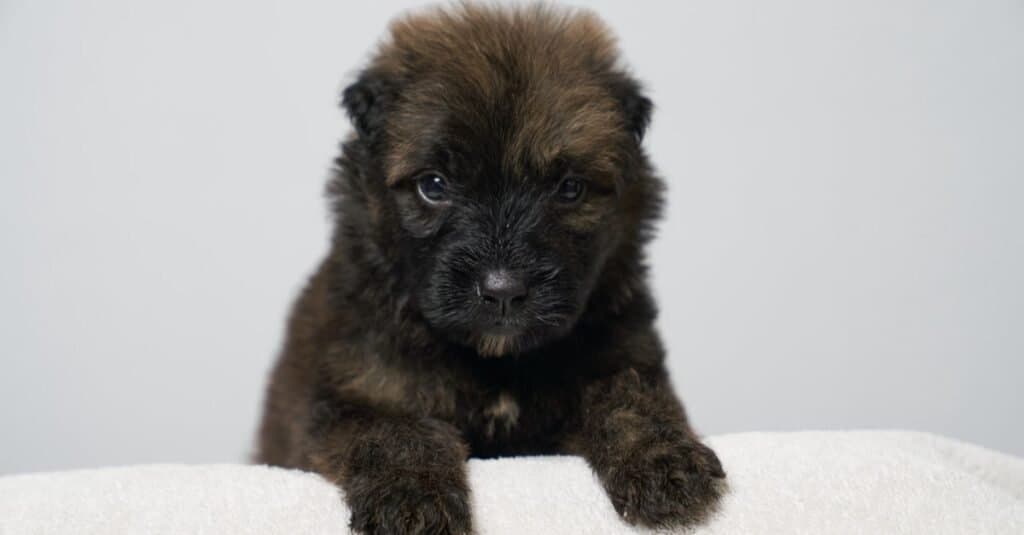
Bouvier puppies should be socialized and trained from an early age.
©Bridgemont Photography/Shutterstock.com
The Bouvier des Flandres and Children
The Bouvier will get along fairly well with children of all ages. It is loyal, protective, and gentle with them. But you should never leave your dog alone with children unless there’s an adult present, just in case you need to intervene.
Dogs Similar to the Bouvier des Flandres
The Bouvier most closely resembles herding dogs from the same region.
- Belgian Shepherd: This medium-sized herding dog is found in four varieties based on its coat length and color: the long-haired black Groenendael, long-haired fawn Tervuren, rough-haired fawn Laekenois, and short-haired fawn Malinois. These dogs are very intelligent, alert, hard-working, loyal, and protective.
- Berger Picard: Also known as the Picardy Shepherd, this medium-sized French herding dog has a rough coat with fawn or brindle hair. The breed is very easy-going and good-natured but can be somewhat reserved around strangers.
- Bearded Collie: This Scottish herding dog has a kind and gentle temperament and is known for its long, flowing double coat of black, blue, brown, fawn, or white fur.
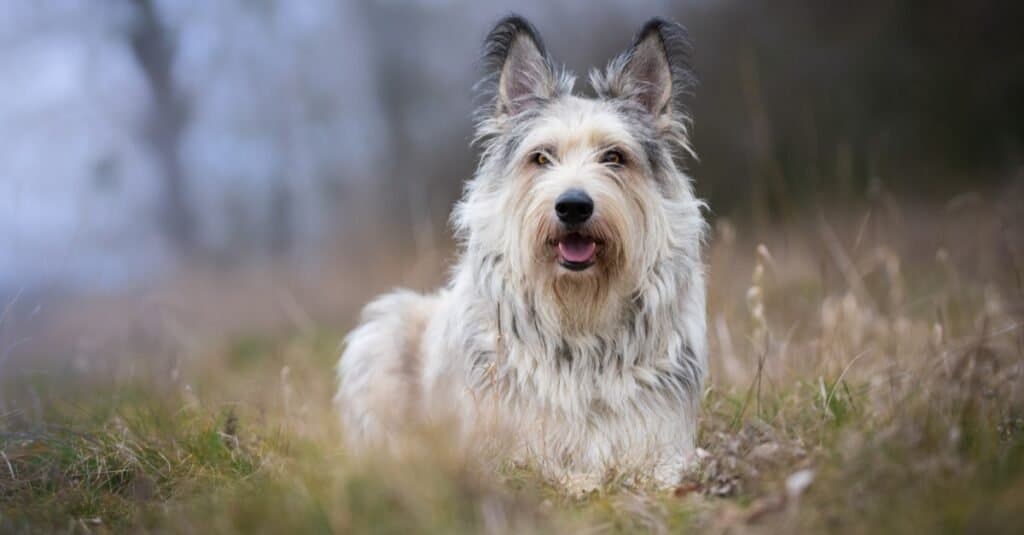
The Berger Picard is a herding dog like the Bouvier Des Flandres.
©TMArt/Shutterstock.com
Famous Bouvier des Flandres Dogs
Perhaps the most famous Bouvier ever was Lucky, the pet of President Ronald Reagan and Nancy Reagan when they were in the White House during his second term. Nancy Reagan named the dog after her mother, Edith Luckett Davis. This breed has also made minor appearances in films and TV shows.
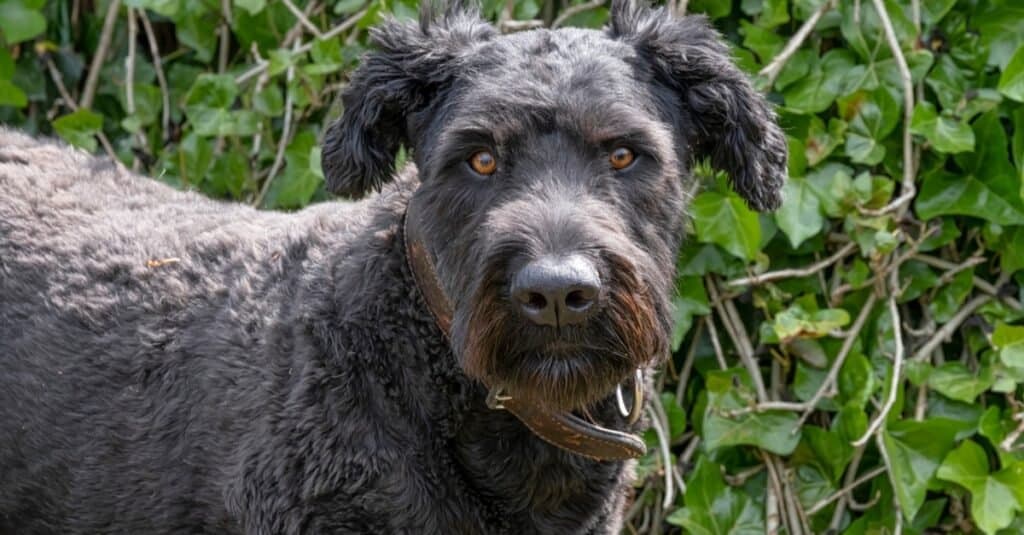
The Bouvier des Flandres has appeared on TV series and in movies.
©DasyaDasya/Shutterstock.com
Popular Names for the Bouvier des Flandres
If you are still unsure about what to call your new Bouvier des Flandres, then you might want to consider one of the following options:
- Rocky
- Victor
- Charlie
- Lucky
- Sierra
- Coco
- Brandy
- Sofie
- Belle
View all 386 animals that start with B
The price of a new Bouvier des Flandres is normally somewhere between 1,200and1,200 and 1,200and1,500 on average. Both the quality of the breeder and the pedigree of the dog will go a long way toward determining the overall price. Remember, high-quality breeders also tend to produce healthy, well-raised dogs. If you can’t afford this, then adoption might be an appealing alternative. Perhaps the best way to adopt a Bouvier is to get in touch with a trusted Bouvier organization. The American Bouvier Rescue League, for example, is specifically dedicated to finding a good home for Bouvier rescues. The price of adoption is usually no more than a few hundred dollars.
Yes, the Bouvier is considered to be a good family dog with a decent lifespan. It is loyal, protective, affectionate, and playful. While this breed does require a lot of work, it can be a very rewarding experience for the right owner.
The Bouvier is very affectionate toward people, but you should keep in mind this isn’t a lap dog. Don’t expect it to always be in the mood for cuddles and snuggling. This dog is task-oriented and needs its own personal space from time to time.
Yes, the Bouvier does shed, but a lot of the loose fur becomes trapped in the coat and must be brushed out. It’s less likely to get on furniture and clothing. This breed is unfortunately not hypoallergenic. Allergy sufferers should be wary.
The Bouvier must exhibit a high degree of intelligence out in the field when herding cattle and sheep. It has the capacity to understand a goal and how to achieve it. What’s most impressive, though, is its sheer versatility. This breed can excel at tricks, sports, games, police and rescue work, guide work, guard duty, and all sorts of other tasks.